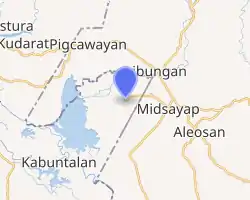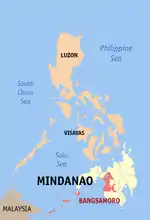Northern Kabuntalan
Northern Kabuntalan, officially the Municipality of Northern Kabuntalan (Maguindanaon: Ingud nu Northern Kabuntalan; Iranun: Inged a Northern Kabuntalan; Tagalog: Bayan ng Northern Kabuntalan), is a 5th class municipality in the province of Maguindanao, Philippines. According to the 2015 census, it has a population of 25,232 people. [3]
Northern Kabuntalan | |
|---|---|
| Municipality of Northern Kabuntalan | |

| |
.svg.png.webp) Northern Kabuntalan Location within the Philippines | |
| Coordinates: 7°12′06″N 124°28′29″E | |
| Country | |
| Region | Bangsamoro Autonomous Region in Muslim Mindanao (BARMM) |
| Province | Maguindanao |
| District | 1st District |
| Founded | December 30, 2006 |
| Barangays | 11 (see Barangays) |
| Government | |
| • Type | Sangguniang Bayan |
| • Mayor | Datu Umbra B. Dilangalen |
| • Vice Mayor | Mary Jane C. Bayam |
| • Representative | Datu Roonie Q. Sinsuat Sr. |
| • Electorate | 13,146 voters (2019) |
| Area | |
| • Total | 106.77 km2 (41.22 sq mi) |
| Elevation | 10 m (30 ft) |
| Highest elevation | 38 m (125 ft) |
| Lowest elevation | 0 m (0 ft) |
| Population | |
| • Total | 25,232 |
| • Density | 240/km2 (610/sq mi) |
| • Households | 3,069 |
| Economy | |
| • Income class | 5th municipal income class |
| • Poverty incidence | 56.42% (2015)[4] |
| • Revenue | ₱88,951.02 (2016) |
| Service provider | |
| • Electricity | Maguindanao Electric Cooperative |
| Time zone | UTC+8 (PST) |
| ZIP code | 9606 |
| PSGC | |
| IDD : area code | +63 (0)64 |
| Climate type | tropical climate |
| Native languages | Maguindanao Ilianen language Tagalog |
During the second regular session of the first legislative assembly of the Autonomous Region in Muslim Mindanao, the regional legislature created Northern Kabuntalan out of 11 barangays of Kabuntalan, by virtue of Muslim Mindanao Autonomy Act No. 206,[5] which was subsequently ratified in a plebiscite held on December 30, 2006. The town was part of the province of Shariff Kabunsuan until its nullification by the Supreme Court in July 2008.
The ARMM law creating the municipality provides that its administrative center shall be established in barangay Tumaguinting.
Geography
Barangays
Northern Kabuntalan is politically subdivided into 11 barangays.
- Balong
- Damatog (Poblacion)
- Gayonga
- Guiawa
- Indatuan
- Kapimpilan
- Libungan
- Montay
- Paulino Labio
- Sabaken
- Tumaguinting
Climate
| Climate data for Northern Kabuntalan, Maguindanao | |||||||||||||
|---|---|---|---|---|---|---|---|---|---|---|---|---|---|
| Month | Jan | Feb | Mar | Apr | May | Jun | Jul | Aug | Sep | Oct | Nov | Dec | Year |
| Average high °C (°F) | 32 (90) |
32 (90) |
33 (91) |
33 (91) |
31 (88) |
30 (86) |
30 (86) |
30 (86) |
31 (88) |
31 (88) |
31 (88) |
31 (88) |
31 (88) |
| Average low °C (°F) | 22 (72) |
22 (72) |
22 (72) |
23 (73) |
24 (75) |
24 (75) |
23 (73) |
23 (73) |
23 (73) |
23 (73) |
23 (73) |
22 (72) |
23 (73) |
| Average precipitation mm (inches) | 38 (1.5) |
24 (0.9) |
29 (1.1) |
31 (1.2) |
50 (2.0) |
56 (2.2) |
52 (2.0) |
49 (1.9) |
39 (1.5) |
47 (1.9) |
54 (2.1) |
35 (1.4) |
504 (19.7) |
| Average rainy days | 10.1 | 7.5 | 10.0 | 11.5 | 19.7 | 20.8 | 19.4 | 18.5 | 16.3 | 18.5 | 18.4 | 12.8 | 183.5 |
| Source: Meteoblue (modeled/calculated data, not measured locally)[6] | |||||||||||||
Demographics
| Year | Pop. | ±% p.a. |
|---|---|---|
| 2007 | 22,170 | — |
| 2010 | 14,251 | −14.86% |
| 2015 | 25,232 | +11.49% |
| Source: Philippine Statistics Authority [3] [7] [8][9] | ||
Economy
| Poverty Incidence of Northern Kabuntalan | |
| Source: Philippine Statistics Authority[10][11][12][13] | |
References
- Municipality of Northern Kabuntalan | (DILG)
- "Province: Maguindanao". PSGC Interactive. Quezon City, Philippines: Philippine Statistics Authority. Retrieved 12 November 2016.
- Census of Population (2015). "ARMM – Autonomous Region in Muslim Mindanao". Total Population by Province, City, Municipality and Barangay. PSA. Retrieved 20 June 2016.
- https://psa.gov.ph/sites/default/files/City%20and%20Municipal-level%20Small%20Area%20Poverty%20Estimates_%202009%2C%202012%20and%202015_0.xlsx; publication date: 10 July 2019; publisher: Philippine Statistics Authority.
- "Muslim Mindanao Autonomy Act No. 206; An Act Creating the Municipality of Northern Kabuntalan in the Province of Maguindanao, Providing Funds Therefor, and for Other Purposes" (PDF). Regional Legislative Assembly, Autonomous Region in Muslim Mindanao. Retrieved 27 January 2016.
- "Northern Kabuntalan, Maguindanao : Average Temperatures and Rainfall". Meteoblue. Retrieved 19 January 2019.
- Census of Population and Housing (2010). "ARMM – Autonomous Region in Muslim Mindanao". Total Population by Province, City, Municipality and Barangay. NSO. Retrieved 29 June 2016.
- Censuses of Population (1903–2007). "ARMM – Autonomous Region in Muslim Mindanao". Table 1. Population Enumerated in Various Censuses by Province/Highly Urbanized City: 1903 to 2007. NSO.
- "Province of Maguindanao". Municipality Population Data. Local Water Utilities Administration Research Division. Retrieved 17 December 2016.
- "Poverty incidence (PI):". Philippine Statistics Authority. Retrieved 28 December 2020.
- https://psa.gov.ph/sites/default/files/2006%20and%202009%20City%20and%20Municipal%20Level%20Poverty%20Estimates_0_1.pdf; publication date: 3 August 2012; publisher: Philippine Statistics Authority.
- https://psa.gov.ph/sites/default/files/2012%20Municipal%20and%20City%20Level%20Poverty%20Estima7tes%20Publication%20%281%29.pdf; publication date: 31 May 2016; publisher: Philippine Statistics Authority.
- https://psa.gov.ph/sites/default/files/City%20and%20Municipal-level%20Small%20Area%20Poverty%20Estimates_%202009%2C%202012%20and%202015_0.xlsx; publication date: 10 July 2019; publisher: Philippine Statistics Authority.
External links
- Northern Kabuntalan Profile at PhilAtlas.com
- MMA Act No. 205 : An Act Creating the Municipality of Northern Kabuntalan in the Province of Maguindanao
- Newly created provinces, municipalities, barangays, converted city Accessed on March 9, 2006.
- Philippine Standard Geographic Code
- Philippine Census Information
- Local Governance Performance Management System

